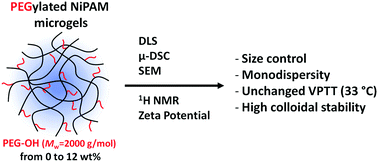PEGylated NiPAM microgels: synthesis, characterization and colloidal stability†
Abstract
The objective of this work is to synthesize highly stable thermoresponsive microgels that could be used in diverse applications. To achieve this, N-isopropylacrylamide (NiPAM) based microgels were first synthesized by surfactant-free precipitation polymerization of NiPAM in the presence of poly(ethylene glycol)methacrylate (PEG) as a macro-comonomer and methylenebisacrylamide (MBA) as a chemical crosslinker. By combining a complete set of techniques such as dynamic light scattering (DLS), scanning electron microscopy (SEM), zetametry, 1H NMR and micro-differential scanning calorimetry (μDSC), we clearly demonstrate that (i) the incorporation of the PEG chains controls the size and the polydispersity of the NiPAM-based microgels, whereas the thermal behavior in solution (enthalpy, volume phase transition temperature (VPTT)) remains almost the same as for pure NiPAM microgels; (ii) the PEG chains are mainly located on the microgel periphery; and (iii) the presence of the PEG chains strongly increases the colloidal stability of microgels in electrolyte solutions at high temperatures.



 Please wait while we load your content...
Please wait while we load your content...